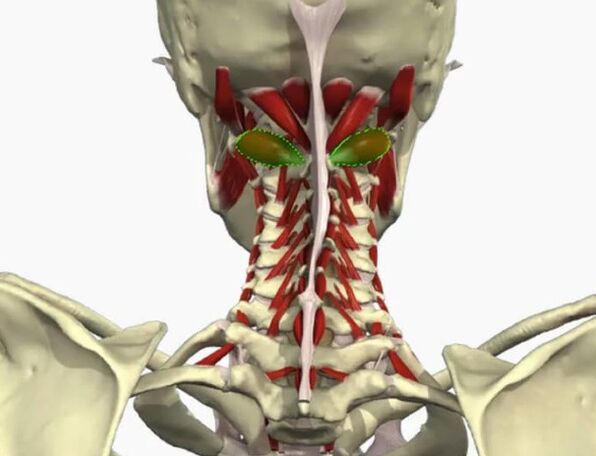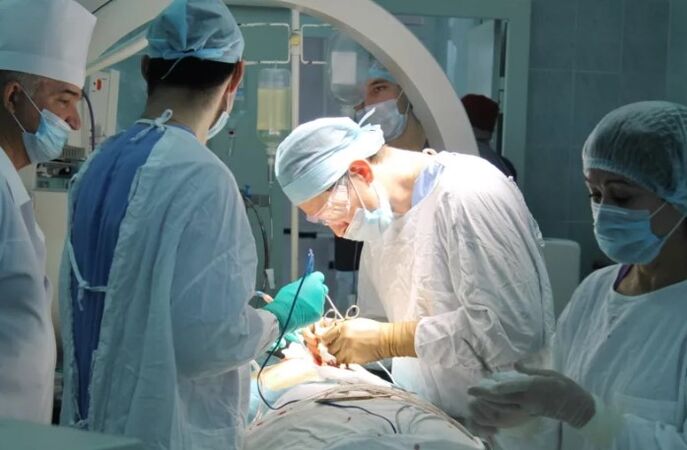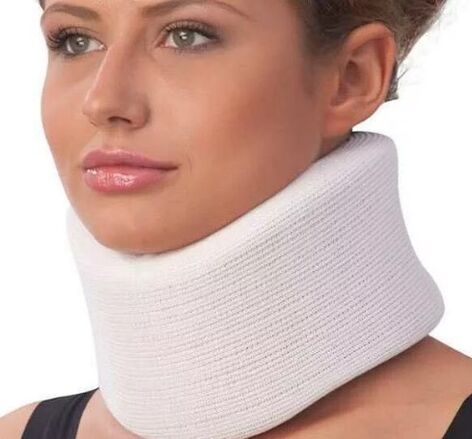Cervical osteocondrosis- This is a disease that is a process of infringement of nutrition or gradual destruction of the cartilage tissue in the intervertebral joints and neck slices.

How do you carry your head on your shoulders lightly?
If it is difficult for you to turn your head when your name is on the street, if your throat doesn't literally hold the word and only get you pain, it's time to check yourself for osteocondrosis.
It is the cervical part that is most prone to damage as it is the most mobile and at the same time has a weak muscle cross. On small mobile vertebrae, the body creates a great strain. And the spinal cord itself is quite narrow. It is easily pressed by any pressure on it.
Thousands of people feel the difficulty in the back of the head or tingling in their hands. And not suspected of the danger, they call such physiological manifestations with fatigue and a nearby cold. A lot of blood vessels and nerve endings are concentrated in the neck. With osteocondrosis, the vertebral artery is pressed, providing nutrition of cerebellum, an oblong brain and the back of the brain. As a result, a person's coordination of movements fails, a loss of a feeling of equilibrium is possible, the vision decreases, hears deteriorating, and sometimes this phenomenon leads to a stroke.
Fact. According to WHO statistics, people aged 30 to 40 years suffer from cervical osteocondrosis. Doctors explain this trend with a mass drop in physical activity. And the spread of this disorder in industrialized countries is equated by 60-80%.
Syndromes and symptoms of osteocondrosis
- Stenosis (narrowing syndrome of the spinal cord duct): Press the tub on the spinal cord in the broken by the intervertebral slices, osteophytes (bone tissue growth) or thickened spine ribbon. As a result, blood circulation is disturbed in the affected area. A person begins to feel limited, feels a noticeable pain in the cervix ridge. In the upper and lower extremities are numerous and icing
- Rook Syndrome: Press the intertebral nerve roots. This leads to headaches expressed in sore, burning or pulsating impulses, sometimes resembles sensations the symptoms of hypertension. In this syndrome, speech error and decreased odor, hypertrophy of the facial muscles, damage to the sensitivity of the linguistic muscles may occur a feeling of "clogging" of the neck with lumps. Breathing becomes interruption, a person suffers from snoring, he often seems to be unreasonable, "laid" his nose.
- Vail artery syndrome: It is formed during compression (compression) of the spine. Its main satellite is pulsating pain. Attacks can catch parietal proportion, the area over the eyebrows, the temporal and occipital shares.
- Cardial Syndrome:It looks like attacks by angina pectoris, but their duration is much larger. Pain is reflected in the membrane. In some individuals, this phenomenon is accompanied by increased blood pressure, arrhythmia.

The main causes of the development of the disease
- Malfunction in metabolism;
- Lifestyle with low motor activity;
- Hereditary disposal;
- Age -related ossification;
- Clamps in the muscles as a result of the attitude changing;
- Lack of fluid and vitamins in daily diet;
- A long stay in an unpleasant position that increases the pressure on disks and spine;
- Overweight or overload to the spine due to wearing heels;
- All kinds of transmitted spinal cord injuries;
- Regular weightlifting;
- Autoimmune diseases (the process of self -distribution of the immune system) leading to degeneration of cartilage tissue;
- Stress that leads to muscle spasms and a violation of blood flow to intervertebral disks;
- Hypothermia.
Diagnosis of cervical osteocondrosis
The starting diagnosis of "osteocondrosis in the cervical-thoracic department" or just the cervical ward can do a doctor already during the initial examination of the patient. The expert determines:
- Type of physics of a person;
- Pose;
- Line of spinous processes;
- Cervical lateral contours and angle on the placement of the shoulder blades;
- Location of pain points and the level of pain;
- The amplitude of the spine
- Muscle relief.

All this together tells you exactly how the disease flows. Furthermore, the doctor will send to a series of examinations:
- Digital radiography;
- CT (computed tomography);
- MRI (magnetic resonance image);
- Ultrasound dopplogram of brain's most important arteries: A special ultrasound sensor determines the condition of blood flow and walls of blood vessels.
The treatment methodics for osteocondrosis of cervical spine
The doctor will help choose the most optimal solution to the problem. And he will offer a number of treatment methods: medicine in combination with physiotherapy or prescribes an operation that is saved for your body.
Conservative treatment- This is first and foremost drug therapy. She relieves pain, relieves muscle tension and turns off inflammation. For such purposes, do not prescribe –Asteroid anti -inflammatory drugs (NSAIDs) and painkillers. Chondroproprotectors also fall into the recipe list to activate recycling processes in the collection tissue in the collection as well as Group B vitamins and external drugs: gels and ointments containing NSAIDs.
PhysiotherapyOn his side, the nutrient media saturates in the cartilage tissue of the intervertebral disc and contributes to the regeneration of cartilage. The doctor will also write exercises for therapeutic gymnastics - to strengthen the muscle corset and develop the flexibility of the ligament apparatus. You can complete an initial lesson with you, so you will perform exercises correctly exercises correctly.

Surgical treatmentIt is appropriate if the drug and physical effects cannot be provided. It is turned to him if the patient has a spinal canal catastrophically narrow. Operational intervention is called anterior cervical discoCtomy. The surgeon immobilizes the affected spinal cord segment and removes the intervertebral hernia pressing on the spinal nerve. Over time, the vertebrae are fed with which the disk was removed fed. This is called spondylodesis. For several of them, a specialist can perform an operation with cage stabilization - that is, intervertebral space is filled with an artificial effort.
After 3-5 days, the driven from the hospital is prescribed for policinic treatment. Rehabilitation takes an average of approx. 3 months and depends on the patient's established implant and professional activity.
What is the best way to build a human lifestyle with a diagnosis of neck osteochondrosis?
The daily routine should include mandatory hiking while jumping and running are better to avoid. It is contraindicated for a long time to spend time in a seating position, swimming is useful - it not only strengthens the muscle tone, but also relieves spasms that limit the body. In the evening it will not be superfluous to take a hot shower (with the exception of the treatment period of the cervix region during the deterioration of the disease). It is important to follow the diet. Use products saturated with magnesium and calcium - nuts, dairy and seafood, legumes. We will have to give up alcohol.
Is it possible to visit the sauna during the worsening of osteocondrosis?
Usually heating is beneficial to the patient, but after increased praise you will have to refuse to dive into cold water. You can't run out of frost. Otherwise, there will be a worsening of the disease. Cervical osteocondrosis is sensitive to any temperature differences, including climatic. For example, autumn cooling may have a negative impact on a person's well.
What complications can occur after osteocondrosis in the cervical region?

If the first signs of the disease appear, so as not to start a course of treatment, the neck can stop obeying you in the literal sense of the word. And the complications of this disease are quite serious. There is a risk of protrusion - the so -called "projection" of the intervertebral disc outside the spine, which is then able to acquire the shape of a hernia. Nerve roots in the neck can be injured. Or oste -huts (bone growth on the vertebrae) appear. The words are often weakened by muscles or palsy - a condition when the head begins to hang on the side or forward. In this department, vertebral arteries that feed the brain with blood with blood are in the processes of the vertebrae of the cervix. Violation of this blood circulation is one of the most severe phenomena. Unwillingness to be treated can lead to neuralgia, deafness and even loss of vision. But if you deal with the solution of the problem, even at the early stage of its development, the disease can be prevented.
Why do you need a Chantsi's collar?
This is an orthopedic lock made of flexible material used to immobilize the neck in the treatment of cervical osteocondrosis. But it is impossible to carry such a device to fix the neck for a long time as the muscles can be weakened over time and you will get used to involuntarily tilting your head to the sides without further support. Chanesa -nul position does not allow the vertebrae to change and retain the corrective effect after the massage session. He takes over the weight of the head and distributes it right to the bone and bottom of the neck. At the same time, the head remains in the correct position.




























